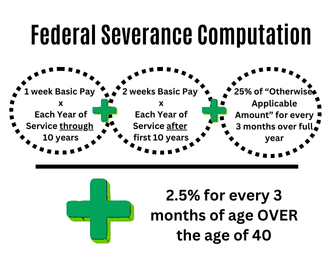Vital information about severance pay for federal employees involuntarily separated from federal employment, including eligibility and conditions of eligibility.
Understanding Severance Pay, VSIP, and Recent Buyout for Federal Government Employees
Severance pay is a crucial aspect of employment that provides financial support to employees who are separated from their jobs. Severance pay differs from a Voluntary Separation Incentive Payment (VSIP), and the recent deferred resignation buyout, because both of those would be considered voluntary. Severance pay, on the other hand, is for federal employees who were involuntarily vacated from their federal job. This article explores the eligibility requirements and how federal employees who were recently let go due to a reduction-in-force (RIF) can receive their severance.
What is Severance Pay and How Does it Apply to Federal Employees?
Definition of Severance Pay
Severance pay is a financial compensation provided to employees who are involuntarily separated from their positions. It serves as a buffer to ease the transition from federal employment to other opportunities. For federal employees, severance pay is authorized under specific conditions and is designed to mitigate the financial impact of job loss. The severance pay is calculated based on the employee’s basic pay and years of service, ensuring that those who have dedicated significant time to federal service receive adequate support.
Eligibility Criteria for Federal Employees
To be eligible for severance pay, a federal employee must meet certain criteria. Primarily, the employee must be involuntarily separated from federal service, which means the separation is not due to personal misconduct or voluntary resignation. Additionally, the employee must have completed at least 12 months of continuous federal service. Eligibility also depends on the specific circumstances of the separation, such as a reduction in force or other organizational changes. Employees who meet these criteria are entitled to severance pay, providing them with financial stability during their transition. To be eligible to receive severance pay, the federal employee must have been filling a “qualifying appointment,” served at least 12 months of continuous service, and not have been terminated for inefficiency, which is defined as unacceptable performance or conduct. In some cases, an involuntary separation might qualify for FERS Discontinued Service Retirement if the employee meets certain additional criteria.
If the worker is eligible for an immediate federal retirement under FERS or CSRS, or military retirement, then they are not able to receive official severance pay.
Use our Federal Retirement Calculator to estimate your FERS pension.
What is a Qualifying Appointment?
| Qualifying Appointments | Non-Qualifying Appointments |
| Competitive Service (GS) | Non-Covered Agency Appointment with Intermittent Schedule |
| Senior Executive Service (SES) | Presidential Appointment |
| Excepted Service Position without Time Limitation | Emergency Appointment |
| Overseas Limited Appointment without Time Limitation | Excepted Service under Schedule C |
| “Status Quo” Appointment | Noncareer SES Term Appointment |
| Time Limited Appointment in Foreign Service | Overseas Appointment with Time Limitation |
| Limited/Emergency Appointment in SES | |
| Veteran’s Readjustment Appointment | |
| President Management Fellows Appointment |
Differences Between Severance Pay and Other Benefits
Severance pay differs from other benefits such as retirement pensions or unemployment insurance. While retirement benefits are based on an employee’s age and years of service, severance pay is specifically for those who are involuntarily separated. If you’re planning for retirement, you may also want to explore the biggest financial considerations when retiring from a federal career. Unemployment insurance, on the other hand, is a temporary financial assistance program for those actively seeking new employment. Severance pay is a one-time payment or series of payments designed to support the employee immediately following their separation from federal service.
How is Federal Severance Pay Calculated?
Factors Affecting Severance Pay Calculation
The calculation of federal severance pay involves several factors, including the employee’s basic pay, years of service, and age adjustment. The basic severance pay allowance is determined by the employee’s rate of basic pay at the time of separation. Additionally, the number of weeks of severance pay is influenced by the employee’s length of service, with one week of pay for each year of service up to 10 years, and two weeks of pay for each year beyond that. Age adjustment may also augment the severance pay allowance, multiplying the total amount granted to employees 2.5% for every 3 months of age over 40 years old.
Calculate Severance Pay for Federal Employees Facing Involuntary Separation

Understanding the Rate of Basic Pay
The rate of basic pay is a critical component in calculating severance pay. It refers to the employee’s salary at the time of separation, excluding bonuses or other forms of compensation. The basic pay for the position held by the employee is used to determine the severance payments, ensuring that the compensation reflects the employee’s most recent earnings. The basic pay figure does include locality pay.
What is a Voluntary Separation Incentive Payment (VSIP)?
VSIP vs. Severance Pay: Key Differences
While both VSIP and severance pay provide financial support to separating employees, they serve different purposes and have distinct eligibility criteria. VSIP is a lump-sum payment to employees who choose to leave federal service, whereas severance pay is for those who are involuntarily separated. Additionally, VSIP is often used as a tool for workforce management, allowing agencies to achieve budgetary or organizational goals, while severance pay is a statutory benefit for eligible employees.
What Happens During a Reduction in Force (RIF)?
Understanding Involuntary Separation
A Reduction in Force (RIF) is in effect across agencies in an effort to significantly shrink the size of the federal workforce. During a RIF, employees may be involuntarily separated from federal service. This process is governed by specific regulations, ensuring that separations are conducted fairly and transparently. Employees who are involuntarily separated during a RIF might be eligible for severance pay, providing them with financial support as they transition to new opportunities.
Severance Pay Entitlements in a RIF
During a RIF, employees who are involuntarily separated are typically entitled to severance pay, provided they meet the eligibility requirements. The severance pay is calculated based on the employee’s basic pay and years of service, with additional adjustments for age. This financial support is designed to help employees manage the transition from federal service, providing them with the resources they need to pursue new opportunities. Understanding the entitlements and calculation of severance pay is essential for employees affected by a RIF.
Reach Out to Us!
If you have additional federal benefit questions, contact our team of CERTIFIED FINANCIAL PLANNER™ (CFP®), Chartered Federal Employee Benefits Consultants (ChFEBC℠), and Accredited Investment Fiduciary (AIF®) professionals. At PlanWell, we are federal employee financial advisors with a focus on retirement planning. Learn more about our process designed for the career fed.
Preparing for federal retirement? Check out our scheduled federal retirement workshops. Sign up for our no-cost federal retirement webinars. Make sure to plan ahead and reserve your seat for our FERS webinar, held every three weeks. Want to have PlanWell host a federal retirement seminar for your agency? Reach out, and we’ll collaborate with HR to arrange an on-site FERS seminar.
Want to fast-track your federal retirement plan? Skip the FERS webinar and start a one-on-one conversation with a ChFEBC today. You can schedule a one-on-one meeting on our Contact Page.









